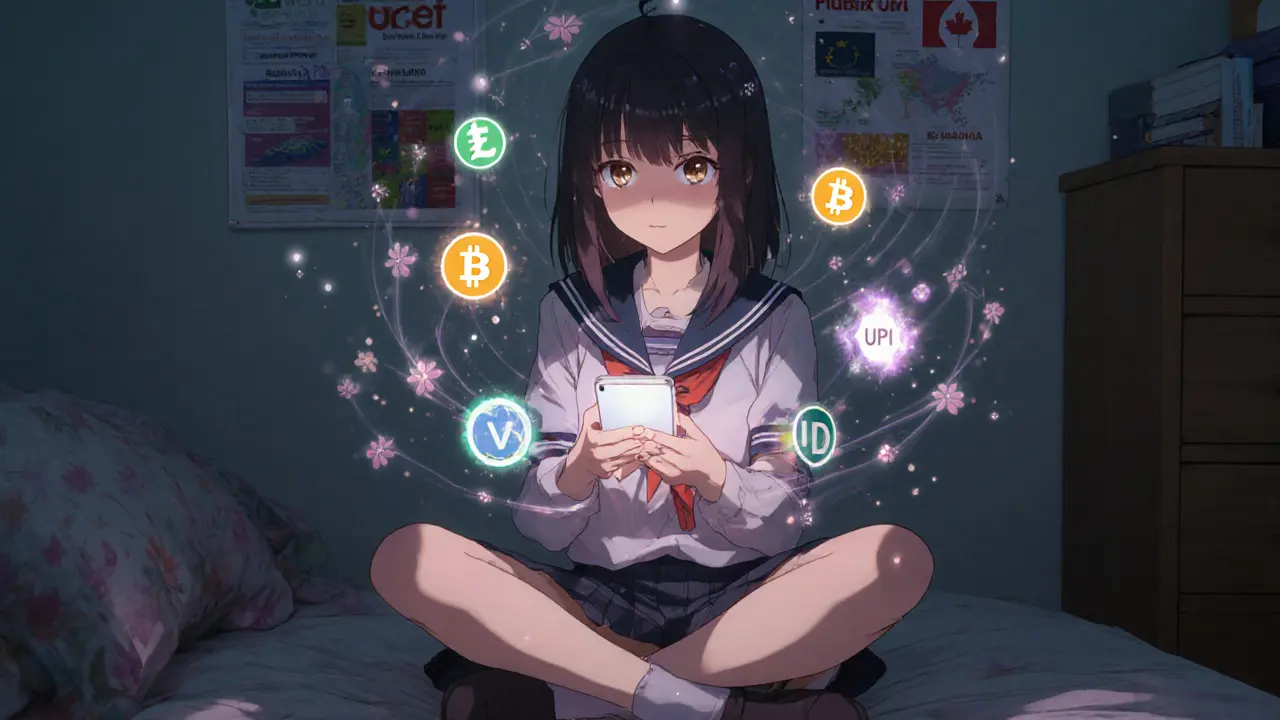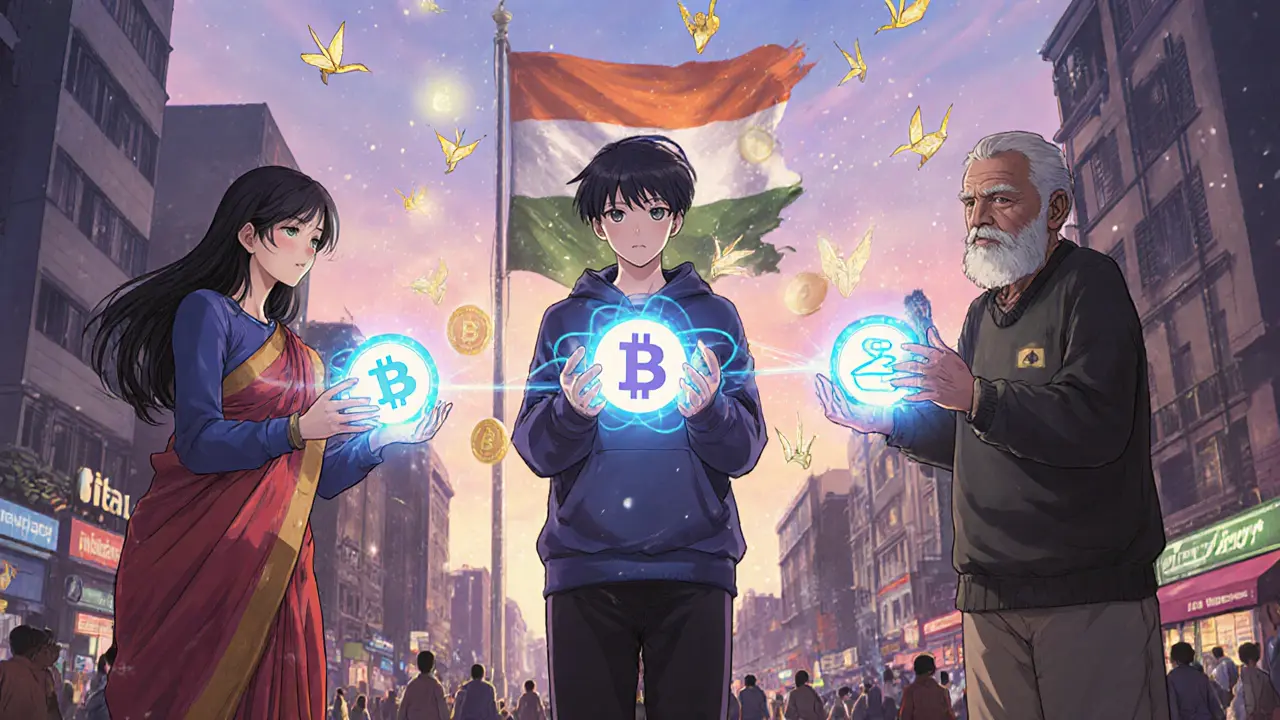Crypto Adoption in India: How Users Bypassed Restrictions to Lead the World
 Nov, 24 2025
Nov, 24 2025
India Crypto Tax Calculator
Calculate Your Crypto Taxes in India
This calculator shows how India's 30% capital gains tax and 1% TDS apply to your transactions.
Enter Your Transaction Details
Your Tax Calculation Results
Capital Gain
30% Capital Gains Tax
1% TDS
Total Tax Due
Net Value After Taxes
India ranks first in the world for cryptocurrency adoption - not because of government support, but despite it. While other countries scrambled to ban or heavily regulate digital assets, Indian users kept buying, trading, and building with crypto. Even with a 30% tax on gains and a 1% TDS on every transaction, crypto use exploded. Between July 2024 and June 2025, India accounted for over $2.36 trillion in on-chain transactions - more than any other country. And it wasn’t just Wall Street types or tech elites. Students in small towns, street vendors, gig workers, and family-run shops all got involved.
Why India’s Crypto Boom Defies Logic
Most countries see crypto adoption as a threat. India treated it like a problem to be taxed, not a tool to be understood. The government slapped on a 30% capital gains tax - one of the highest in the world - and added a 1% tax deduction at source (TDS) on every crypto trade. No deductions. No losses offset. Just pure tax on every profit, no matter how small. Yet adoption didn’t slow. It accelerated. The reason? India already had the infrastructure for digital money. The Unified Payments Interface (UPI) made sending money as easy as sending a text. Over 10 billion UPI transactions happen every month. People were already used to moving money instantly through their phones. When crypto apps came along - with wallets that worked just like UPI apps - adoption wasn’t a leap. It was a natural step. Bitcoin became the gateway. Between July 2024 and June 2025, Indian users on-ramped $4.6 trillion in fiat into Bitcoin alone - more than any other country put together. People didn’t start with complex DeFi protocols. They bought Bitcoin on apps like CoinSwitch, ZebPay, or Bitbns, held it as a savings tool, and traded small amounts when they needed cash. For many, it was the first time they had access to a global asset that wasn’t tied to the rupee’s fluctuations.The Grassroots Movement Nobody Saw Coming
You won’t find this story in official reports. It’s in WhatsApp groups in Jaipur, TikTok tutorials in Lucknow, and YouTube videos in Tamil explaining how to send USDT to a cousin in Dubai. In rural Karnataka, farmers use crypto to sell produce to exporters without waiting weeks for bank clearance. In Bengaluru, college students build DeFi bots to automate arbitrage between Indian and international exchanges. In Delhi, a single mom runs a side business selling handmade jewelry, accepting USDC payments from customers in the U.S. and Europe. This isn’t speculative investing. It’s survival. It’s opportunity. When inflation hit 7% and bank interest rates stayed below 6%, crypto offered a real alternative. People weren’t chasing moonshots. They were looking for stability. Stablecoins like USDT and USDC became digital rupees with global backing. You could hold them, send them, and cash out anytime - no bank approval needed. The Bharat Web3 Association, a coalition of local developers and entrepreneurs, started hosting free workshops in 300+ cities. They didn’t talk about blockchain theory. They taught: “How to set up a wallet,” “How to send crypto to a friend,” “How to avoid scams.” Within two years, they trained over 2 million people - mostly women and first-time users.
Institutional Adoption: The Quiet Shift
While retail users drove the volume, institutions quietly followed. Indian fintech startups began integrating crypto as a settlement layer. Payment processors started offering crypto-to-fiat on-ramps for SMEs. Even traditional banks, wary at first, began partnering with regulated crypto exchanges to offer custody services to high-net-worth clients. The biggest signal? Institutional adoption now leads the world in Chainalysis’ 2025 index - and India is #1. Hedge funds based in Mumbai are allocating 5-10% of their portfolios to Bitcoin and Ethereum. Family offices in Pune are buying Bitcoin as a long-term store of value, just like gold. Indian venture capital firms have poured over $1.2 billion into Web3 startups since 2023 - more than any other country in Asia. What changed? Regulation didn’t become friendlier. But enforcement did. Law enforcement agencies stopped raiding crypto offices. Instead, they started working with exchanges to trace illicit flows. The Reserve Bank of India, once openly hostile, now quietly monitors crypto transaction patterns to understand capital flight and money laundering risks. The message? We can’t stop it. So let’s manage it.The Tax Trap That Didn’t Kill Crypto
The 30% tax and 1% TDS were meant to scare people away. Instead, they forced innovation. People stopped trading daily. They started holding longer. They began using crypto for cross-border payments to avoid high forex fees. A small business owner in Hyderabad now sends $5,000 in USDT to a supplier in Vietnam instead of using SWIFT - saving $150 in fees and cutting settlement time from 5 days to 5 minutes. Tax reporting became a pain point - but also a catalyst for tools. Local developers built free, open-source tax calculators that auto-sync with major Indian exchanges. Apps like KoinX and CryptoTaxIndia now help over 3 million users file their crypto taxes accurately. The government didn’t make it easy - but Indians made it work.
What’s Next? A Bitcoin Reserve Could Change Everything
Rumors are swirling that India is considering holding Bitcoin as part of its foreign reserves. Not as a speculative asset. As a hedge. A backup. A way to reduce dependence on the U.S. dollar. If true, this would be the most significant shift since the 2018 RBI ban on banking crypto firms. Why now? Because India’s digital economy is too big to ignore. The country has 800 million smartphone users. 70% of them are under 35. They don’t trust banks the way their parents did. They trust apps. They trust transparency. They trust assets that aren’t controlled by a single government. A Bitcoin reserve wouldn’t mean legalization. But it would mean recognition. It would signal that crypto isn’t just a fringe activity anymore - it’s part of India’s financial DNA.Why India’s Model Matters Everywhere
India didn’t wait for permission. It didn’t need a legal framework to start using crypto. It had a problem - unstable currency, slow banking, high fees - and crypto solved it. The government tried to tax it into submission. The people adapted. This isn’t an outlier. It’s a preview. Countries with weak financial infrastructure, high inflation, or restricted banking systems will follow the same path. Nigeria, Argentina, Turkey - they’re already seeing similar patterns. India’s story proves one thing: you can’t stop adoption when the need is real. You can only delay it. And when you tax it, regulate it, or ignore it - people still find a way. The future of crypto isn’t in Silicon Valley or Wall Street. It’s in the hands of a student in Bhopal buying Bitcoin with her part-time earnings. In a tailor in Ahmedabad accepting USDT from a client in Canada. In a farmer in Odisha using stablecoins to get paid instantly for his harvest. That’s adoption. Not regulation. Not hype. Real use.Is cryptocurrency legal in India?
Yes, cryptocurrency is legal in India. There’s no outright ban. However, the government imposes strict taxes: 30% on all capital gains and 1% TDS on every trade. Exchanges operate under these rules, and users must report crypto income in their tax returns. While not officially recognized as legal tender, crypto is treated as a digital asset under tax law.
Why is India leading in crypto adoption despite heavy taxes?
India leads because its people use crypto for practical reasons - not speculation. With a weak banking system, high forex fees, and inflation, crypto offers faster, cheaper cross-border payments and a stable store of value. UPI’s success made digital payments normal, so crypto adoption felt natural. Even with taxes, users found ways to benefit - like using stablecoins for international trade or holding Bitcoin as long-term savings.
What role do stablecoins play in India’s crypto market?
Stablecoins like USDT and USDC are the backbone of India’s crypto economy. They’re used for everyday transactions, remittances, and cross-border payments because they’re pegged to the U.S. dollar and avoid rupee volatility. Over 60% of crypto transactions in India involve stablecoins. They’re the digital equivalent of cash for millions who need reliable value without bank delays.
How do Indians pay taxes on crypto?
Indians pay 30% tax on every crypto profit, with no deductions for losses. A 1% TDS is deducted automatically on every trade. Most users use tax software like KoinX or CryptoTaxIndia to auto-import transaction history from exchanges and generate tax reports. These tools help users calculate gains, losses, and TDS credits - making compliance easier despite the complex rules.
Is a Bitcoin reserve likely in India?
Rumors suggest India is exploring holding Bitcoin in its foreign reserves, similar to El Salvador. While not confirmed, the move would signal official recognition of crypto’s role in financial stability. If true, it would be a major shift from taxation to strategic adoption - acknowledging that crypto is now too embedded in the economy to ignore.

Soham Kulkarni
November 25, 2025 AT 15:56Tejas Kansara
November 26, 2025 AT 10:09jocelyn cortez
November 26, 2025 AT 19:48